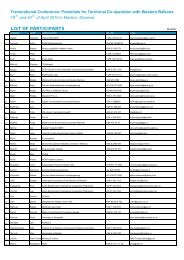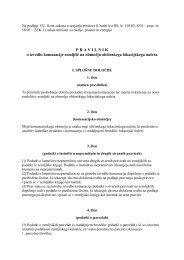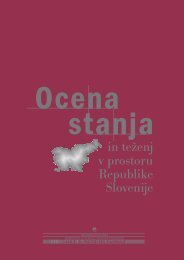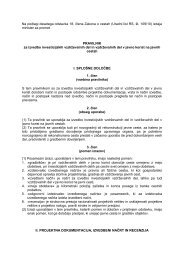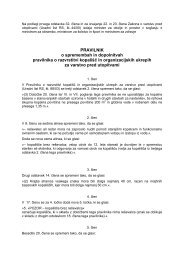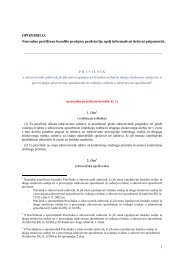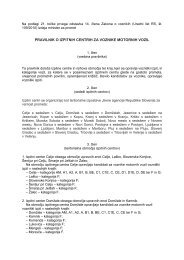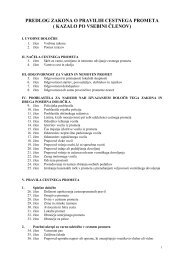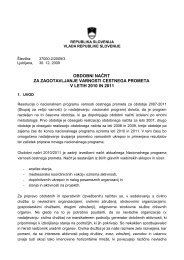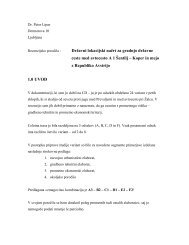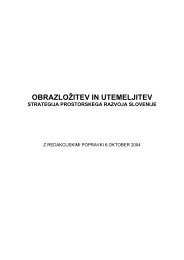evropska konvencija o krajini - Ministrstvo za infrastrukturo in prostor
evropska konvencija o krajini - Ministrstvo za infrastrukturo in prostor
evropska konvencija o krajini - Ministrstvo za infrastrukturo in prostor
You also want an ePaper? Increase the reach of your titles
YUMPU automatically turns print PDFs into web optimized ePapers that Google loves.
2. Diagram cikličnih <strong>in</strong>terakcij med posameznikom, družbo <strong>in</strong> kraj<strong>in</strong>o, ki prikazuje oblikovanje konceptualnih kategorij.Diagram of cyclical <strong>in</strong>teractions between the <strong>in</strong>dividual, the society, and the landscape that shows the formation of conceptual categories.tisto, kar <strong>prostor</strong> predstavlja 4 . Če to velja <strong>za</strong> našeosebne odnose do <strong>prostor</strong>a, lahko sklepamo, davelja toliko bolj <strong>za</strong> katerokoli ideološko podprtoidentifikacijo, tudi <strong>za</strong> identifikacijo s ponovnoustvarjeno evropsko skupnostjo.Kraj<strong>in</strong>ska identiteta je družbeni konstrukt, kisicer nastane na podlagi določenega fizisaoziroma prepoznavnih kraj<strong>in</strong>skih vzorcev, vendarso ti v procesih družbene komunikacije, kiizkorišča kolektivni spom<strong>in</strong>, preobraženi <strong>in</strong>obloženi z dodatnimi pomeni (konotacijami). Stem družbene konvencije <strong>in</strong> spoznavadiferencirajo, ovrednotijo <strong>in</strong> prevrednotijokraj<strong>in</strong>sko identiteto <strong>in</strong> skonstruirajo splošnosprejeto predstavo o identiteti nekegadoločenega <strong>prostor</strong>a. Tako nastala družbenakoncepcija <strong>prostor</strong>a oziroma kraj<strong>in</strong>e je potemtista, ki preko vrednostnega sistema neposrednovpliva na družben odnos do <strong>prostor</strong>a/<strong>kraj<strong>in</strong>i</strong>n na njeno ravnanje z njim. Posameznikidružbeno predstavo o <strong>prostor</strong>u posvojijo prekoprocesov <strong>in</strong>kulturacije, t. j. ponotranjanja, tako,da ta ali bolje rečeno množica teh predstavvplivajo tudi na posameznikov odnos <strong>in</strong> nanjegovo posamezno ravnanje. Kar pomeni, dakraj<strong>in</strong>e vrednotimo <strong>in</strong> preurejamo v skladu zneko splošno sprejeto, največkrat idealno, odstvarnosti odmaknjeno podobo.Zakaj množ<strong>in</strong>a? Zato, ker lahko soobstaja večvzporednih kocepcij <strong>prostor</strong>a, ki izmeničnostopajo v ospredje, odvisno od trenutnih potreb.Potrebe niso samo pragmatične, temveč tudiideološke, kakršna je naprimer potreba povzpostavljanju ali ohranjanju nacionalne(<strong>prostor</strong>ske) identitete. Predvsem je jasno, daimajo posamezniki svoje lastne predstave oIf we assume that along the measurable spaceand objectively given phenomena, which onecould call landscape identity the question ismore about the relationship towards the landscape,i.e. about the identification with the landscape,then their coexistence is quite believable.Human feel<strong>in</strong>gs of belong<strong>in</strong>g can live side byside, same do feel<strong>in</strong>gs of belong<strong>in</strong>g to variouslevels of landscapes. National identification isl<strong>in</strong>ked to places and landscapes <strong>in</strong> which themean<strong>in</strong>g was spontaneously (or <strong>in</strong>tentionally)<strong>in</strong>vested. It does not orig<strong>in</strong>ate, simply from thephysical reality of the space but rather primarilyfrom the mean<strong>in</strong>gs attached to this reality 4 . Ifthis is true for our personal relationship to theenvironment, we can afford to assume this iseven truer for any ideologically based identificationwith space.Landscape identity is a social construct. It isformed on the basis of the geographical characteristicsof the certa<strong>in</strong> physis or for example recognisablelandscape patterns, but once theyenter the processes of social communicationthey become transformed, twisted and burdenedwith connotations. This is how social conventionand cognition differentiate, evaluate andreconfigure landscape identity and constructsuch conception of space or landscape that isgenerally accepted. This social conception ofspace or of landscapes uses the social systemof values to <strong>in</strong>fluence social relationship towardsthe environment and adjust the behaviour andaction with<strong>in</strong> it accord<strong>in</strong>gly.The society is a producer and the <strong>in</strong>dividual is aconsumer, who adopts the social conception by45Delavnica 1 / Workshop 14Eno prvih študij o navezovanju na simbolne pomene <strong>prostor</strong>e je izdelala sociolog<strong>in</strong>ja Felizitas Lenz-Romeiss, v Stadt – Die Heimat oder Durchgangstation?(Munchen, 1970).See one of the first thorough sociological f<strong>in</strong>d<strong>in</strong>gs regard<strong>in</strong>g collective place-attachment to the symbolic mean<strong>in</strong>gs of spatial components <strong>in</strong> Felizitas Lenz-Romeiss, Stadt – Die Heimat oder Durchgangstation? (München, 1970).




